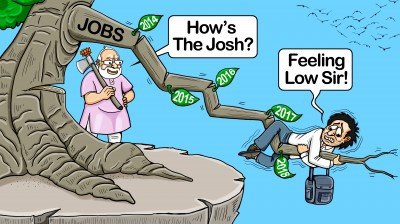A recent report jointly released by the International Labour Organisation (ILO) and the Institute of Human Development (IHD) has shed light on the concerning trend of youth unemployment in India, emphasizing the need for urgent action to address the issue. The report, titled “The India Employment Report 2024,” reveals alarming statistics regarding the unemployment rates among the youth population and underscores the necessity for industry-led initiatives to combat the crisis.
According to the report, India’s youth comprised a staggering 83% of the total unemployed population in 2022. Furthermore, the proportion of educated youth among the unemployed has increased significantly over the years, with educated young people accounting for 66% of the jobless population in 2022, compared to 54% in 2000. Notably, the share of young individuals with at least secondary education has nearly doubled from 35.2% in 2000 to 65.7% in 2022.
Chief Economic Adviser V. Anantha Nageswaran, who released the report, emphasized the need to move away from the notion that the government alone should intervene to solve social and economic problems. Instead, Nageswaran highlighted the crucial role of the commercial sector in driving hiring and job creation.
The report also highlighted disparities in youth unemployment rates based on educational attainment, with the unemployment rate among graduates reaching as high as 29.1% in 2022. Furthermore, women, particularly those with graduate degrees, were disproportionately affected by unemployment, with women not engaged in employment, education, or training accounting for nearly five times the proportion of their male counterparts.
Despite improvements in some labour market indicators post-2019, including the Labour Force Participation Rate (LFPR) and Worker Population Ratio (WPR), challenges persist. The report pointed out widespread insecurities regarding livelihoods, highlighting the prevalence of informal employment and the decline in regular employment post-2018.
Moreover, the report raised concerns about the insufficient growth of non-farm sectors to absorb workers from agriculture, urging economic policies aimed at bolstering productive non-farm employment, particularly in the manufacturing sector.
In addition to addressing the structural challenges in the labour market, the report emphasized the importance of equipping youth with the necessary skills for employment. It revealed that a significant portion of young individuals struggle with basic digital literacy skills, hindering their employability in an increasingly digitized world.
Looking ahead, the report forecasted a decline in India’s youth population by 2036, underscoring the urgency of implementing effective measures to address youth unemployment and ensure sustainable economic growth. It called for collaborative efforts between the government, industry, and other stakeholders to provide meaningful employment opportunities for India’s youth population.
Image Credit- Quora


